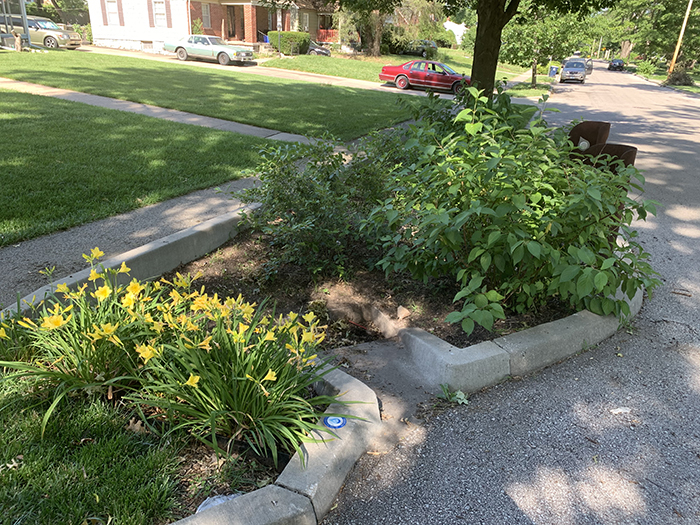A Comprehensive Guide to Stormwater BMPs
Posted on Wednesday, June 24th, 2020 by Affinis CorpIn Stormwater, tagged in

Stormwater Best Management Practices (BMPs) offer a number of environmental benefits to overall water quality. They can remove pollutants, reduce runoff volumes, and increase biological diversity through the use of native plantings that attract wildlife. A great tool for moving communities forward, we’ve outlined a variety of BMPs, how they work, and keys to their success below.
There are a variety of BMP options. However, they share some common traits. To begin, they are all designed with some means to capture or convey stormwater. Often BMPs are planted with native vegetation, which helps filter out pollutants and increase stormwater uptake through the plant roots. Where native plants are used, the planting media is typically comprised of some percentage of sand, mixed with topsoil or compost. This allows the plants the nutrients they need to thrive while also allowing water to infiltrate or move through the media filtering pollutants. In areas where the native soils do not allow further infiltration, a drain pipe is added to remove excess water.
Stormwater BMPs are designed to mimic some of the natural conditions of a particular area, such as capturing runoff, filtering pollutants, reducing runoff rates, etc. Solutions often fall into these categories:
- Rain Garden or Bioretention Feature: This is a graded low area, planted with native vegetation that collects stormwater runoff. The vegetation is planted in a soil media that provides nutrients for plants to grow and allows water to move through the media. Where the native soils do not allow much infiltration, a perforated drain pipe at the bottom of the feature is added.
- Filtration Swale, Bioswale, or Filter Strip: A linear feature that receives stormwater at one end and conveys it over and through native vegetation to capture pollutants is categorized this way. The soil in the swale is typically amended with a sand and compost mix to increase infiltration along it.
- Mechanical BMP: Typically found within a stormwater structure along a pipe system, a mechanical BMP uses hydraulics to settle pollutants and capture floatables. Mechanical BMPs can also include filters that remove pollutants.
- Water Reuse: These have features like rain barrels or larger storage tanks that collect runoff and store it for future use to water vegetation or other non-potable water uses. Water reuse systems can be quite complicated, including filters, mechanical BMPs, or even disinfection systems to clean the runoff before re-use.
- Permeable or Porous Pavement: Hard surface areas (parking lots, streets, sidewalks, etc.) are covered by a permeable or porous surface that allow them to be drivable or walkable, but also permits stormwater to filter through the surface into a sand or rock layer below. This type of BMP both filters pollutants and captures stormwater.
- Detention or Retention Pond: A dry or wet (has a permanent pool of water) pond that has a pipe outlet to limit the discharge rate out of the pond. The water quality benefit in ponds is their ability to capture and settle out pollutants and reduce runoff rates.
How Stormwater BMPs Work
At their core, BMPs are designed to capture, store, and treat stormwater runoff. Stormwater enters the BMP usually on a small scale, so the size of the BMP can fit with the landscape. It then moves through a filter media (sand or compost) or standing water pool that facilitates settling of sediment. Native plants are often incorporated to filter pollutants and take-up runoff, as well as enhance aesthetics. In cases where water is not absorbed by the vegetation or infiltrates into the surrounding soil, perforated pipe in the bottom of the BMP carries away excess water.
How to Maintain Stormwater BMPs
BMPs are designed to address water quality, but when they are not maintained, they become much less effective. Similar to other infrastructure, they need to be inspected regularly. At Affinis, we recommend looking for the following signs to indicate the need for maintenance:
- Is there standing water in the BMP days after a rain event?
- Is the BMP collecting trash or filling with sediment?
- Is erosion happening in or around the BMP?
- Are the plants healthy? Do any need to be replaced?
- If there is mulch on the surface, does it need to be replenished?
When it comes to maintenance, time is of the essence. BMPs will fail within the first year if they are not maintained. Protecting your investment with regular inspections and maintenance is critical. BMPs in residential settings often have the greatest success, when it comes to maintenance. In those cases, residents take ownership and become a willing partner in long-term maintenance. These aesthetically pleasing solutions can become a source of pride, as well as a centerpiece for the area, when positioned appropriately.